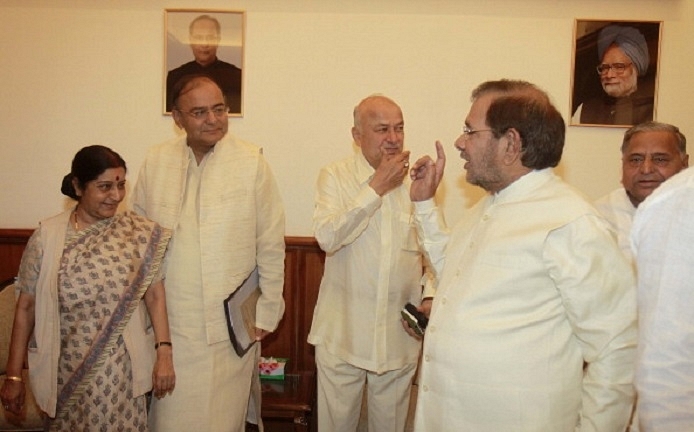Politics
After JNU, Govt Can Take The Money Bill Route For Central GST, Aadhaar

By Sonu Mehta/Hindustan Times via Getty Images
Modi government has got its tactics wrong in deciding how to deal with a recalcitrant opposition. Facing another wash-out in the upcoming budget session, it should rather push the important bills through the money bill route.
Now that the Jawaharlal Nehru University (JNU) imbroglio is likely to isolate the NDA in parliament even further, the Narendra Modi government needs to develop a new short-term strategy to speed up some reforms using the money bills route. Money bills can be passed by parliament even if the Rajya Sabha blackballs them, and declaring a bill as money bill is entirely within the speaker’s powers.
The goods and services tax (GST) bill will, obviously, be the first casualty of the JNU fracas and the Rohith Vemula suicide – both of which will enable the opposition to make house functioning impossible. But there is a partial way out if the centre decides to implement GST only for central taxes – that is by merging the excise and service taxes at the centre, as Seetha points out in this article in the Swarajya website.
While the bigger GST needs a constitutional amendment, nothing stops the centre from merging the excise and service tax acts, especially since both are administered by the central excise department. A unified central GST will set the stage for the states to walk in later, even one at a time. The idea should be to let the states know that GST progress can be a coalition of the few and the willing, and that the stragglers may end up paying a price if they wait too long.
The second thing is to activate the JAM trinity – that is Jan Dhan, Aadhaar and Mobile payments system – by giving the Aadhaar unique ID project a legal basis. Once again, this can be done by making it a money bill – and this is justifiable since the idea is to route subsidies to the poor from the exchequer. Currently, Aadhaar usage faces many restrictions from the Supreme Court, which is hearing a petition to outlaw it, as it breaches privacy by taking your finger-prints and biometric information without any backing in law.
The UPA could not get the National Identification Authority of India Bill 2010 passed as the parliamentary committee attached to the finance ministry gave it a thumbs down.
However, under Narendra Modi, Aadhaar already covers 970 million people, and additionally, the government has been using it to ensure direct transfer of LPG subsidy benefits to bank accounts. The idea now is to extend it to kerosene, and, at some point, even food. It cannot be extended if the Supreme Court puts a further crimp in the lifeline.
A Times of Indiareport suggests that the government may well bring in an Aadhaar bill labelled as a money legislation. It may be called the Aadhaar (Delivery of Benefits, Subsidies and Services) Bill 2016, and could have additional provisions to protect the privacy of the data collected from citizens and ensure data security. The report says the attorney general has already given the green signal to it.
Aadhaar as a money bill, and this will enable the government to move the Supreme Court for enabling its compulsory use for the disbursal of monetary benefits to the poor. Once such a law is passed, it could herald the greatest reform in subsidy deliveries in Indian history.
Another bill worth pursuing as a money bill is the Bankruptcy Code, which has some tax angles. The bill, as currently introduced, has gone to a joint Lok Sabha-Rajya Sabha committee in order to prevent the upper house from bottling it up indefinitely. But in case it still suffers the same fate, it is worth having a more limited bankruptcy code reintroduced as a money bill, albeit with more tax-related provisions in it to justify the tag.
The bankruptcy code will, among other things, enable bankrupt companies to be wound up in six months, thus speeding up the recovery process of bad loans by the sale of available assets.
There is, or course, a limit to how many bills can be called money bills, but some key ones surely are worth the effort, especially the combining of central goods and services taxes, and the Aadhaar direct benefits transfer bill. Both will be landmark bills, even if the GST is a truncated one.
The problem for the Modi government is that it got its tactics and strategy all wrong in deciding how to deal with a recalcitrant opposition. It first tried to ram legislation down the opposition’s throat, and then gave them a handle to disrupt parliament after Sangh loudmouths made atrocious sectarian comments, and pushed the anti-beef agenda ham-handedly.
Now, of course, the Modi government is on the backfoot with the Vemula and JNU controversies giving the opposition a fresh reason to disrupt.
It is best to use the money bill route judiciously in the budget session so that some pieces of legislation can be passed through the normal route after the state assembly elections are done and dusted post the budget session. Hopefully, wiser counsel will prevail in the opposition by that time.
Introducing ElectionsHQ + 50 Ground Reports Project
The 2024 elections might seem easy to guess, but there are some important questions that shouldn't be missed.
Do freebies still sway voters? Do people prioritise infrastructure when voting? How will Punjab vote?
The answers to these questions provide great insights into where we, as a country, are headed in the years to come.
Swarajya is starting a project with an aim to do 50 solid ground stories and a smart commentary service on WhatsApp, a one-of-a-kind. We'd love your support during this election season.
Click below to contribute.
Latest